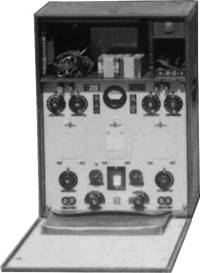Inhaltsverzeichnis
SE-214: Portable Radio Station 18/25
Portable Radio Station 18/25, T.S.25 („Tragbar Schwer“); made by Telefunken, Zurich.
In the years of the First World War, when very broadband spark transmitters were used and the insufficient selectivity of the receivers could not pick out a wanted signal from the general wave chaos, H. Bredow developed a valve transmitter. General Staff Colonel Hilfiker managed to organize wireless equipment to be brought for testing to Switzerland, the Telefunken station U.S.17/D or it's transceiver ARS 68a gotthe designation „Portable Heavy Station (18)“. Inititally, the regenerative receiver integrated in the set was used, but it turned out to bee to unsensitive, so later the Telefunken receiver, the Telefunken E266, was acquired and the receiver valves were eliminated from the set.
In the following years, the station material of the „portable heavy radio station“ saw repeated renewals: The transmitter was replaced by the Telefunken AR125 and the somewhat more powerful AR245. The receiver E266 from 1922 was replaced by the „Receiver 25“ (Spez 7Bs) and after 1932 by the „Receiver 31“ (Spez 470 Bs). After the signal department was created in 1925, the station with the improved equipment got the designation „Portable Heavy Radio Station 25“. After 1951, the station was in fact already faded out, it got the designation SE-214.
Specifications
- Principle: radio station with separate transmitter and receiver
- Frequency Range: approx. 166 - 1000 kHz
- Output Power: 7-10 W (ARS68) to 20 W (AR245)
Configuration 1918
- Transmitter ARS68 from Telefunken
- Receiver: built-in regenerative receiver
Configuration 1922
- Transmitter ARS68 from Telefunken
- Receiver: E266 from Telefunken
Configuration 1925
- Transmitter AR125 from Telefunken
- Receiver: Spez 7Bs with NF amplifier Spez 60Bs from Telefunken
- Transmitter AR245 from Telefunken
- Receiver: Spez 7Bs with NF amplifier Spez 60Bs from Telefunken
Configuration 1932
- Transmitter AR245 from Telefunken
Power Supply
- Generator Petrol generator MAG 2C36, 12-24V 6A and 800V 0.1 A or rotary rotary generator for emergency operation
- for the receiver accumulators 6 V and plate batteries
Dimensions
- various
Accessories
- The standard antenna used was a 50 m L or T antenna between two 9 m masts.
Station Material
The transmission branch of the Meissner transmitter US17/D resp. ARS 68b of the original „Portable Heavy Station“ was equipped with only one transmitter triode RS5.
In 1925 it was replaced by the newly developed transmitter AR125; with two triodes RS5 this had an antenna ouput power of 15 watts. From 1926 on, the slightly improved transmitter AS245 was used, with it's two triodes RS55 it achieved an antenna output power of 20 W, the operating range was specified as 50 - 75 km.
 The original set had a built-in regenerative receiver, it's volume was nearly inaudible in combat noise, so after 1922 it was replaced by the Telefunken E266 receiver. In 1926 this war replaced by the receiver „Receiver E25“ (Spez 7Bs) with two tuned circuits, equipped with two triodes RE062t, and an additional AF amplifier Spez 60Bs.
The original set had a built-in regenerative receiver, it's volume was nearly inaudible in combat noise, so after 1922 it was replaced by the Telefunken E266 receiver. In 1926 this war replaced by the receiver „Receiver E25“ (Spez 7Bs) with two tuned circuits, equipped with two triodes RE062t, and an additional AF amplifier Spez 60Bs.
 From 1932 on, the station was upgraded with the much more powerful long-wave receiver „Receiver 31“ (Spez 470 Bs), this was equipped with six valves RE074n and was powered with 4 or 6 V filament batteries and two 60V plate batteries.
From 1932 on, the station was upgraded with the much more powerful long-wave receiver „Receiver 31“ (Spez 470 Bs), this was equipped with six valves RE074n and was powered with 4 or 6 V filament batteries and two 60V plate batteries.
The standard antenna material was a two-wire 50 m L or T antenna between two 9 m high masts. The entire station came as 18 payloads, with a total of 336 kg, the station was conditionally „portable“, this means, it could be transported by a carrier platoon or on mules.
Technical Principle
see description of the individual devices
Tube Layout
Development
The German Telefunken society for wireless telegraphy, Berlin, „Undamped station U.S.17/D“ was acquired in 1918/9 and it was introduced in Switzerland as „portable heavy wireless station“.
In a first step to improve the station's performance, the valve transceiver ARS68 with it's integrated poorly performing regenerative receiver, was the elimination of the receiver circuit and use the Telefunken E266 as an external receiver in 1922.
The next step of renewal of the station was the replacement of the transmitter part by a AR125 transmitter in 1925 and by a AR245 transmitter with a slightly higher output in 1926. Then the receiver Telefunken Spez 7Bs with dual tuned circuits and an external AF amplifier Spez 60Bs and from 1932 the receiver Spez 470Bs / E31 was used.
According to the documentation „radio stations of the army“, initially 56 sets were purchased for a price of 16'750.- Fr.















